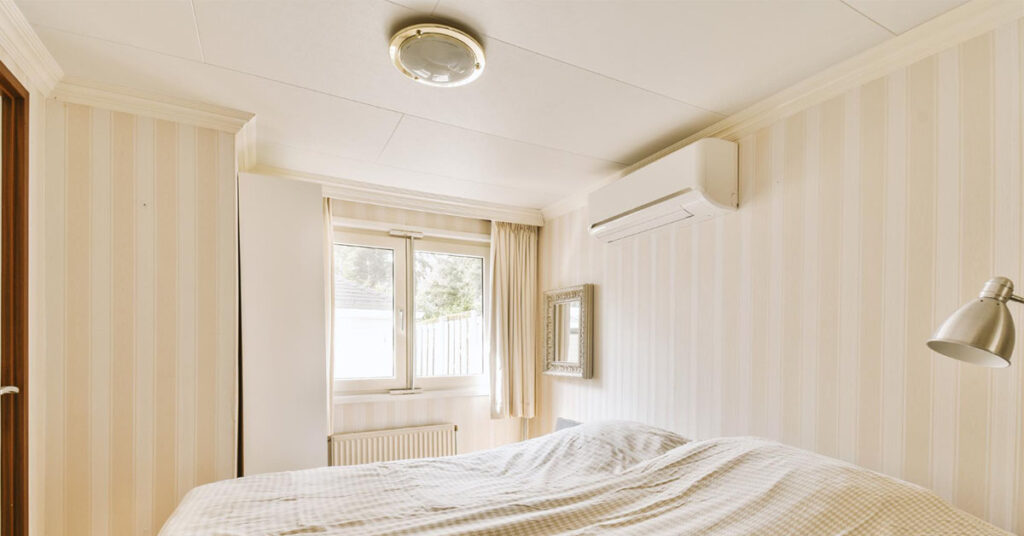The lack of windows poses a unique challenge in bedroom design, ensuring optimal ventilation without natural air flow from outdoors. Proper ventilation is crucial, especially in a space intended for relaxation. Therefore, this comprehensive guide outlines the best ventilation ideas for bedroom without windows.
From strategically positioned fans to air-purifying technology, we explore natural ventilation options. Find cutting-edge alternatives with innovative ventilation systems and specialized panels.
Best Ventilation Ideas for Bedroom Without Windows
Here are a few of the best ventilation ideas for a bedroom without windows.
1. Improve Airflow with an Extractor Fan
You can improve airflow in bedrooms without windows by installing an extractor fan. The mechanical ventilation device keeps the indoor environment healthy. By removing stale air, pollutants, and excess moisture, extractor fans prevent condensation and mold growth. Choosing the right location, typically near moisture-prone areas, ensures optimal performance.
You need the right size fan for your room to maximize efficiency. Installation involves securing the fan, connecting it to the power supply, and attaching ventilation ducts. Keeping your fan running smoothly requires regular testing and maintenance. Extractor fans improve air quality and create a relaxing, comfortable atmosphere in windowless bedrooms.
2. Dehumidifier for Improved Bedroom Ventilation
A dehumidifier is a good solution for windowless bedrooms that need better ventilation. By regulating humidity levels, mitigating excess moisture, and making your home more pleasant, a dehumidifier is a valuable tool. In addition to comfort, the system addresses key ventilation issues.
Dehumidifiers get rid of surplus humidity efficiently, keeping your home dry. In enclosed spaces without windows, this prevents potential problems like mold, mildew, and dampness. Additionally, a low-humidity environment is less conducive to dust mites and mold, which benefits individuals with respiratory sensitivities.
Consider factors like the room’s dimension when choosing a dehumidifier for the bedroom. Strategic placement, ideally in a central location, ensures uniform moisture extraction throughout the space. The dehumidifier’s efficiency will last longer if you maintain it regularly, according to manufacturer guidelines.
3. Enhancing Ventilation with Open Doors
Using open doors strategically can improve ventilation in bedrooms without windows. Using strategically positioned doors, you can improve air circulation and create a more breathable environment.
In addition to allowing fresh air to flow into the room, open doors aid in dispersing stagnant air. This method is excellent for cross-ventilating if there are other openings or windows nearby. Leave bedroom doors ajar or open during the day to allow air to circulate.
While open doors are a straightforward solution, it’s essential to combine them with other ventilation methods. When combined with mechanical ventilation or natural airflow, open doors can ensure a consistent and refreshing atmosphere in windowless bedrooms. Ultimately, Open doors contribute to a more comfortable and inviting bedroom by increasing air circulation.
4. Improving Ventilation with Air Conditioning Units
Installing an air conditioner in a windowless room can provide a comfortable and well-ventilated atmosphere. While air conditioners are traditionally associated with temperature control, they also improve air quality and circulation.
Air conditioners not only cool the air but also remove excess moisture, making it drier and more breathable. The dehumidifying effect helps address issues like mold and dampness in enclosed spaces without windows. Furthermore, air conditioners typically come with filters that trap dust and allergens, thus improving air quality.
Make sure the unit’s capacity matches the size of the room and is appropriately positioned for optimal airflow. Regular maintenance, including filter cleaning, ensures continued efficiency.
It’s advisable to strike a balance between air conditioning and ventilation to avoid overusing it. Windowless bedrooms can benefit from combining air conditioning units with other ventilation strategies, such as open doors or fans.
5. Air Bricks for Improved Ventilation
Windowless bedrooms require strategic ventilation solutions, and installing air bricks is one of them. They help fresh air flow through enclosed spaces with their unassuming, porous design. You can circulate air continuously by installing air bricks in exterior walls or doors.
Air bricks prevent stagnation by constantly exchanging air, preventing stagnation. It improves overall air quality as well as regulates moisture levels, reducing condensation risks. Choose locations on exterior walls that promote air circulation when installing air bricks.
Installation may require professional help to make sure it fits right into the wall structure. The idea is to create air passages so the bedroom is more dynamic and breathable. Using air bricks with other ventilation methods, like fans or open doors, is an excellent way to optimize airflow.
By discreetly incorporating air bricks into your windowless bedroom, you can enhance ventilation and contribute to a more comfortable environment.
6. Fitting a Passive Vent for Improved Ventilation
Consider passive vents as a subtle yet effective solution for better ventilation in windowless bedrooms. Passive vents work without electricity, relying on natural pressure differentials to move air. A passive vent allows fresh air to flow in and stale air to escape, fostering continuous air exchange inside the room.
Selecting the right place, typically on an exterior wall or door, ensures optimal airflow. Choosing the right place complements existing ventilation strategies. By running without electricity, passive vents contribute to energy efficiency beyond just air circulation.
You should choose a passive vent’s size and quantity according to the room’s dimensions. Combining passive vents with other ventilation methods, such as open doors or air bricks, improves overall airflow. The addition of passive vents discreetly addresses ventilation challenges, providing a natural ventilation solution.
Read More: How to Avoid Getting Ripped Off On the Ventilation Project
The Takeaway
These ventilation strategies transform windowless bedrooms into havens of comfort. From extractor fans to air bricks, each solution offers a unique solution to limited airflow. Whether it’s open doors or advanced technologies, the goal is the same: to get fresh, invigorating air to circulate freely. With these ventilation ideas, you can create a healthier, more rejuvenating living environment within your windowless retreat. Embrace the vitality of well-ventilated living and elevate your space.

